For generations, human beings have fantasized about the possibility of finding extra-terrestrial life. And with our ongoing research efforts to discover new and exciting extrasolar planets (aka. exoplanets) in distant star systems, the possibility of actually visiting one of these worlds has received a real shot in the arm. Unfortunately, given the astronomical distances involved, not to mention the cost of mounting an expedition, doing so presents numerous significant challenges.
However, Russian billionaire Yuri Milner and the Breakthrough Foundation – an international organization committed to exploration and scientific research – is determined to mount an interstellar mission to Alpha Centauri, our closest stellar neighbor, in the coming years. With the backing of such big name sponsors as Mark Zuckerberg and Stephen Hawking, his latest initiative (named “Project Starshot“) aims to send a tiny spacecraft to the Alpha Centauri system to search for planets and signs of life.
Consisting of an ultra-light nanocraft and a lightsail, the concept calls for a ground-based laser array to push the lightsail up to speeds of hundreds of kilometers a second, towing the nanocraft into deep space. Such a system would allow the tiny spacecraft to conduct a flyby mission to Alpha Centauri in about 20 years after it is launched, which could then beam home images of possible planets, as well as other scientific data such as analysis of magnetic fields.
In essence, Starshot seeks to leverage recent technological developments to mount an interstellar mission that will reach another star within a single generation. As we explained in another article (“How Long Would It Take To Travel To The Nearest Star?“), using existing technology, it would take between 19,000 to 81,000 years for a spacecraft to make the trip to even the nearest star, depending on whether chemical rockets or ion engines were used.
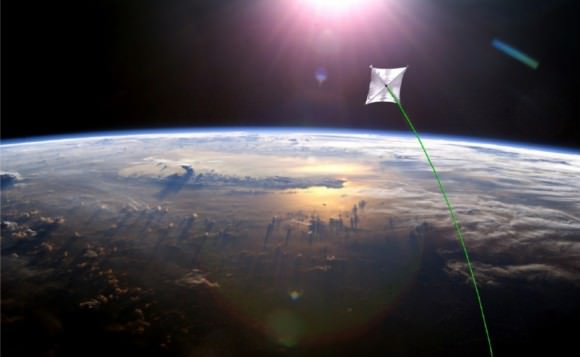
Hence, the Foundation’s advisory board explored all potential methods for creating a craft that could travel at relativistic speeds – up to 20% the speed of light – so it could traverse the 4.37 light year distance in just 20 years. They determined that a tiny craft, roughly the size of a refrigerator magnet and weighing in the vicinity of a few grams, would be the best model for a spacecraft. They further determined that the best propulsion method would be laser-driven lightsail, which is not hampered by the limits of conventional methods.
With a massive ground-based laser directing the sail, the plan is to accelerate the nanocraft to its terminal velocity before it reaches a distance of about one million km from Earth (which is the limit to which the laser beam can be focused on the meter-scale sail). All told, the nanocraft will experience an acceleration of about 60,000 g (sixty-thousands times the force of Earth’s gravity, which works out to just under 600,000 m/s²).
As Professor Avi Loeb, the Frank B. Baird, Jr. Professor of Science at Harvard University and chairman of the Foundation’s Advisory Board, explained to Universe Today via email:
“{O]nly one offers a path forward: using beamed (laser) light to push a sail attached to a lightweight (gram-scale) smart payload (with a camera, transmitter and thrusters). This approach benefits from two major technological advances that were realized recently: miniaturization of electronics (developed by the cell phone industry) and the construction arrays of lasers that combine to make a very powerful and focused beam of light (developed by the defense industry). Interstellar travel is challenging, but based on these technological advances, we believe that there is a path forward without obvious show stoppers. The project is ambitious but doable.”
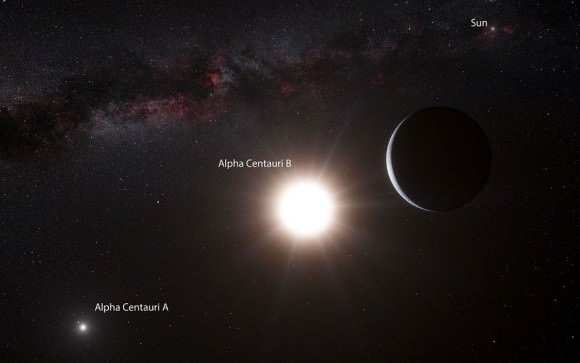
In addition to accomplishing the dream of countless generations (i.e. traveling to another star system), Breakthrough Starshot hopes to generate important supplementary benefits to astronomy in the meantime. Much like the Apollo Program of the 1960s, the Breakthrough Starshot program hopes to stimulate the development of technologies that will be beneficial here on Earth.
These include demonstrating proof-of-concept technology that will enable the exploration the solar system, the detection and study of Near Earth Objects (NEOs), and the benefits to material science that solar sail development will bring. The development of laser arrays will also have major implications for the science of optical systems, and the laser communication devices used on Starshot will likely lead to better communication with airplanes and satellites around Earth.
As Pete Worden, the Executive Director Project Breakthrough StarShot, told Universe Today via email:
“The project goals are to develop and demonstrate the technologies, particularly with respect to high power laser beaming technology and gram-class lightsail-craft that could enable humanity to send these craft to the nearest star system, Alpha Centauri within a generation. We hope to mobilize the world’s expertise to make this possible. The program will be an open international program. Yuri Milner has provided our initial funding. Renowned physicist Stephen Hawking and Facebook founder Mark Zuckerberg have joined Yuri Milner as the governing board of the project.”
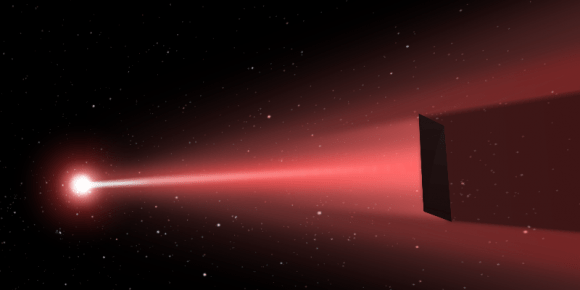
Based on the Foundation’s best estimates, this project could achieve its goal of dispatching their interstellar traveler within a few decades time. And with a 20 some-odd year transit time, we could be gaining vital information about the nearest star system (including whether or not it has life-supporting exoplanets) by the 2050s or 2060s.
Naturally, there are still several engineering hurdles that would need to be overcome before Starshot can become a reality. For example, propelling a gram-scale spacecraft to 20% the speed of light will require a laser beam of that could generate about 100 Gigawatts of power over the course of a few minutes. The Project intends to build this laser array on the ground, simply because that would be much cheaper than building one in space.
This, in turn, creates the challenge of optical-blurring due to atmospheric turbulence. Using adaptive optics (measuring atmospheric effects and correcting for them) is believed to be able to compensate for that. Such a method has been tested on the scale of the largest telescopes (10 meters in diameter), but would need to be tested on a scale of 1 km before it can be considered feasible.
What’s more, there are plenty of doubts as to the missions intended target, not to mention the likelihood that the mission will succeed. For instance, while Alpha Centauri may be the nearest star, thus making it the natural choice for interstellar exploration, there is little reason to suspect we will find any exoplanets there.

Years back, astronomers announced the detection of a possible planet circling Alpha Centauri B with an orbital period of 3.24 days – which was named Alpha Cen Bb. However, subsequent examinations revealed that the detection of this exoplanet was the result of the window function (time sampling) of the original data. If we hope to find exoplanets, then we might need to look further afield – like Epsilon Eridani, a mere 10.5 light years away (which would result in a travel time of 55 years for the proposed nanocraft).
And, as Paul Gilster of Centauri Dreams points out, the concept presents numerous challenges that will require technical advances not currently in existence. For example, beyond the issue of laser power and adaptive optics, there are issues with the sail concept itself that are likely to prove difficult. Essentially, this comes down to the need for a balance to be struck between powerful lasers and a sail that is capable of withstanding them:
“Moreover, we have to design a sail that will ‘ride’ the beam rather than be blown off it, and one that will be so highly reflective that it will absorb less than 1/100,000th of the energy applied to it. These are problems that Robert Forward faced with his Starwisp design, a kilometer-wide ‘spider web’ of a sail driven by microwaves, with sensors scattered throughout the sail itself. It was Geoffrey Landis who would go on to show that as described, Starwisp would likely vaporize under the powerful beam meant to drive it to Alpha Centauri, causing a flurry of re-thinking of sail materials and design. But leaving the fuel at home is a powerful technique, and advances in technology may get us to the kind of materials that can withstand the photon torrent.”
Addressing the design called for by Breakthrough Starshot – a thin, round disc that is about the size of a picnic table in diameter, and which would have its entire electronics suite in the center – Gilster sees additional problems. “We’ve also got a problem in that concept,” he says, “because Jim Benford has pointed out that a flat sail is not a good ‘beam-rider’ – we’ll likely have to look at the kind of curved sail designs both Jim and brother Gregory Benford have studied in lab work at the Jet Propulsion Laboratory.”
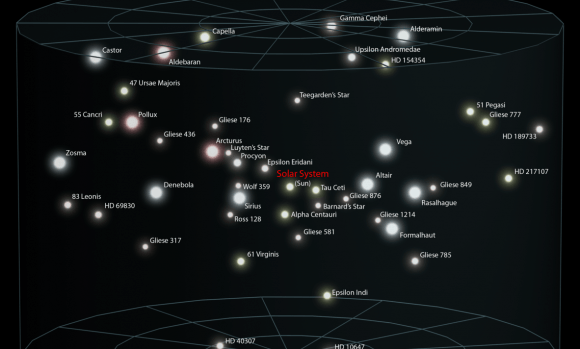
In the end, the only reason to send a probe to Alpha Centauri is because of its proximity. And mounting the mission will require that the Breakthrough Foundation and its supporters come up with new and innovative solutions to the hurdles they face. But given that the opportunities for research and exploration will still be abundant, the reasonable timelines involved, and the likelihood of success, the mission certainly appears to be doable.
Previous efforts by the Breakthrough Foundation’s include Breakthrough Listen, the largest scientist research program aimed at detecting transmissions from distant stars. These include monitoring for radio transmissions and optical laser transmissions using advanced instruments that are significantly more sensitive than anything currently in use, combined with advanced software and data analysis. The program will span 10 years and cost an estimated $100 million, surveying the 1,000,000 closest stars to Earth and the 100 closest galaxies to the Milky Way.
There’s also Breakthrough Message, a $1 million competition aimed at encouraging a global debate about the ethics and possible methods of communicating with possible intelligent beings beyond Earth. The competition is open, and the prize will be awarded to anyone who is able to design a message (in digital format) that best represents Earth and humanity to other civilizations.
And be sure to enjoy this video from the Breakthrough Foundation that illustrates the mission concept:
Further Reading: Breakthrough Initiatives

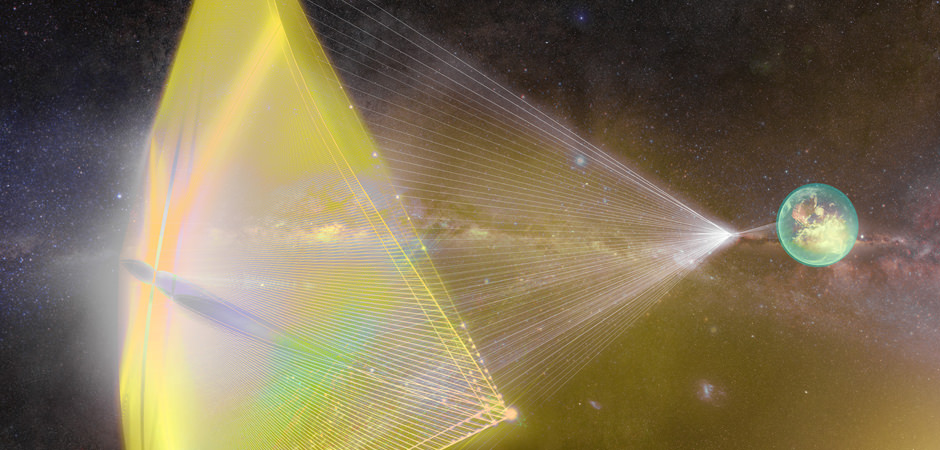
How much useful information can be gathered during a fly-by at 20% the speed of light? How does this information get sent back to Earth? Isn’t New Horizons still transmitting the Pluto data?
I think the chance of this misbegotten scheme succeeding in their timeframe is roughly the same as miniaturizing the LHC to pocket-size by the end of the century.
Your comparison to an LHC mini betrays your complete lack of scientific savvy. Uninformed opinions like this are worthless. Thanks for your time…
The project seems like a stretch in many ways. If the propulsion scheme works at all, how can you boost it with enough accuracy to hit a target light-years away? You would have no mid-course correction option, but that is how real spacecraft work today. When it gets to its target, how is it going to communicate back to Earth? They say using light, but you have to have precision pointing and considerable power that both seem unlikely., even if you use very slow modulation.
And so on. To me, the ground array seems like a much better anti-satellite weapon than a spacecraft driver.
The proposed design comes with tiny photon thrusters for the sake of making course corrections.
http://breakthroughinitiatives.org/index.php?controller=Forum&action=viewforum&id=17&page=2
Just read “Far Centari” Would love to be alive when we intercept our outgoing vehicle. But if we don’t start we will never get there.
Yes, those difficulties not withstanding, & solved, the matter of maintaining the light sail within the laser beam could possibly be solved by making the beam more intense at its circular edges … so any tendency to tip away from the beam is automatically corrected, & the voyager remains on-course?
“push the lightsail up to speeds of hundreds of kilometers an hour”???
Assuming that is not correct and they really want to go 20% of light speed, why do they need so high of an acceleration? Wouldn’t it be easier on the sail design, the spacecraft design and the laser design to accelerate at a few g for several hours or days than 60,000 g for a few minutes?
They need the high acceleration because there’s a limited distance over which they can focus the beam. Not that they couldn’t go with a longer acceleration period, but the efficiency would start dropping off quickly after about a million km.
Not when you consider that the window for reaching the sail in space is short. If you were to maintain a laser array that’s on the gigawatt-end of things for hours or days, it would be considerably more expensive.
BAZBSG, you are right.
20% c is approximately 215 million Km/H.
A dragstrip of 1 million Km is tiny when the final velocity is 215 million Km/H.
Note:: 20% c is approximately 3.6 million Kilometers per Minute.
The laser array and the tracking stations back on Earth will probably be the most difficult and expensive part of the endeavour. Each individual probe will be comparatively cheap. Once the propulsion station is in place, there’s no reason we couldn’t launch probes at numerous target stars.
One criticism I’ve heard is that the proposed laser array could also be used as a weapon. The reply to that would be to build the array on the far side of the moon. The response is that is to orbit a mirror around the moon, then use the mirror to focus the array for vaporizing parts of Earth.. On and on it goes.
So basically until we achieve true peace here on Earth such a project is doomed to fail, at least politically. And the ‘light sail’ is made out of what? Unobtainium?
Intriguing as a pipe dream?
A ground-based laser array would be completely impractical as a weapon, at least the one they have planned. Building such an array on the far side of the Moon and orbital mirrors would make the project no longer cost-effective. As for the sail, they are considering many options; but right now, the top contender is graphene.
If you have doubts about their project, you can read from the website where they list the technical challenges:
http://breakthroughinitiatives.org/index.php?controller=Forum&action=viewforum&id=21&page=2
Technology aside, read The 3-body problem and The Dark Forest by Cixin Liu
Link?
Seems like this is doomed to fail from the start. How are they going to make a surface that reflective which would be able to withstand the stress of acceleration? That material doesn’t exist presently.
Again, the material they are considering for just that purpose is graphene.
http://breakthroughinitiatives.org/index.php?controller=Forum&action=viewforum&id=21&page=2